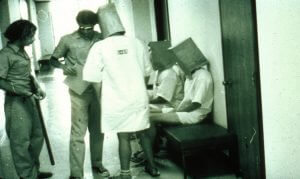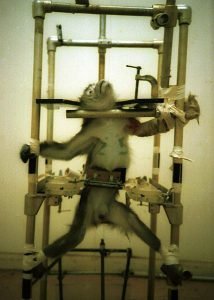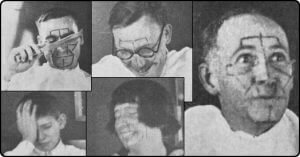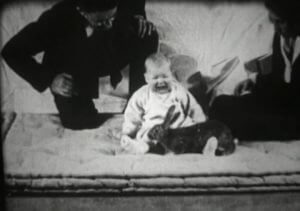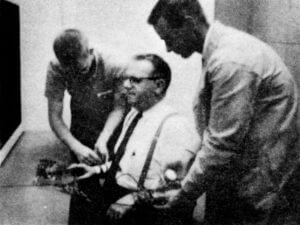
Top 10 Unethical Psychological Experiments
 1
1
 09. 09. 2018
09. 09. 2018

The main task of physicians should be to help sick people. However, there are those who prefer to study nonsensical studies they do not hesitate to use, such as experimental rabbits, silent faces or even people themselves. Let's take a look at ten examples of perverse medical experiments.
1) Monster study
The study was led by Wendell Johnson of the University of Iowa - in 1939 he selected twenty-two orphans suffering from stuttering and other speech defects. The children were divided into two groups. In the first, they received professional speech therapy care and praise for each new progress. However, the subjects in the second group experienced a completely opposite approach. For each imperfection of their speech, they received only ridicule and swearing. The result was, logically, that it was the orphans from the second group who experienced psychological trauma after such an experience and never got rid of stuttering. Johnson's colleagues were so horrified by his actions that they decided to cover up his attempt as much as possible. The general situation in the world, where the eyes of all people were focused on Nazi Germany and its experiments on people in concentration camps, did not play into their hands. The university did not publicly apologize for this attempt until 2001.
2) Aversion Project 1970 - 1980
Between 1970-80, South African apartheid experimented with forced gender reassignment, chemical castration, electrotherapy, and other unethical medical experiments on white lesbian and gay members of the military. The aim of the study was to eradicate homosexuality from the military. The number of victims is estimated at up to nine hundred.
The whole machine began with a statement from the Army officers and chaplains. The victims were then sent to the military psychiatric clinics. Most often to Voortrekkerhoogte near Pretoria. Most of the victims had flights between 16-24.
The chief physician of the experiment, Dr. Aubrey Levin, was suspended and tried only in 2012.
3) The Stanford Prison Experiment 1971
Although this study was not so unethical, its result was so catastrophic that it certainly deserves its place on this list of perverted experiments. Well-known psychologist Philip Zimbardo was behind it all. He wanted to examine individuals divided into two groups: prisoners and guards. He wondered how quickly they adapted to their roles and whether it would be reflected in their mental state.
People who took on the role of guardians were not given any training on how they should behave. It all depended on their judgment. The first day, the experiment was embarrassed, as no one knew how to behave. The next day, however, everything went awry. The prisoners started a revolt, which the guards managed to suppress. As a result, detainees began to mentally tremble to prevent another coup attempt based on their common solidarity. The prisoners soon became disoriented, degraded, and depersonalized beings. This went hand in hand with emerging emotional disorders, depression and feelings of helplessness. During conversations with the prison chaplain, prisoners could not even remember their name, they were only identified by numbers.
Dr. Zimbardo ended his experiment after five days, realizing that he was facing a real prison. The results of the study were therefore more than telling. This was a classic case of abuse of power, often associated with paranoid suspicion. In this case, it was the guards who began to treat their prisoners in an inhumane manner because they feared another uprising.
4) Monkey Drug Trials 1969
Although it is generally believed that animal testing is important to humans, especially in the field of medicines, the fact is that many of them are very cruel. This includes the 1969 monkey experiment. In this experiment, primates and rats were injected with various types of addictive substances: morphine, codeine, cocaine and methamphetamine.
The results were frightening. The animals broke their limbs in an attempt to escape further punctures. The monkeys that received the cocaine apparently bit their fingers in hallucinations, had convulsions, and tore their fur out. If the drug was combined with morphine in addition, death occurred within two weeks.
The purpose of the whole study was to determine the consequences of drug use. However, I believe that every average intelligent person knows the effects of these drugs - that is, unfortunate. Certainly, there is no need for these inhuman experiments on creatures that cannot defend themselves. Rather, it seems that in this experiment, the doctors reprimanded their own hidden desires.
5) Landis' Facial Expressions Experiment 1924
In 1924, Carnes Landis, a graduate of the University of Minnesota, devised an experiment to determine how different emotions change facial expressions. The goal was to find out if all people have the same facial expression when they feel horror, joy and other feelings.
Most of the participants in the experiment were students. Their faces were painted with black lines to follow the movement of their facial muscles. Subsequently, they were exposed to various stimuli, which were to provoke a strong reaction. Then Landis took a picture. Subjects, for example, sniffed ammonia, watched pornography, and shoved their hand into a bucket of toads. However, the final part of the test was debatable.
Participants were shown a live rat to behead. The majority refused, but a third complied. However, none of them knew how to perform this procedure humanely, the animals suffered so immensely. In front of those who refused to do so, Landis decapitated the rat himself.
The study has shown that some people are able to do whatever they say. There was no benefit for facial expressions, for each person seemed different in emotions.
6) Little Albert 1920
The father of behaviorism, John Watson, was a psychologist who longed to find out whether fear is an innate or a conditioned reaction. To do this, he chose an orphan with the nickname Little Albert. He exposed him to contact with several species of animals, showed himself in several masks, and lit various objects in front of him - all for two months. Then he placed him in a room where there was nothing but a mattress. After a while, he brought him a white rat so the boy could start playing with him. After a while, the psychologist began to startle the child with a loud sound, hitting a hammer with a hammer, whenever the rat appeared in the child. Albert became very afraid of the animal after his time, as he associated it with a terrifying sound. And to make matters worse, he developed a fear of anything white and furry.
7) Learned Helplessness 1965 (learned helplessness)
The term was coined by psychologists Mark Seligman and Steve Maier. They tested their theory on three groups of dogs. The first group was released from the leash after some time without any harm. Dogs from the second group were paired in pairs, with one animal in the pair receiving an electric shock, which could, if the dog learned to do so, be terminated by moving the lever. The third group was also in pairs, in which one of the dogs received an electric shock, which could not be stopped. And it was in these individuals that the symptoms of clinical depression appeared.
Later, all the dogs were placed in one box, where they received electric shocks. Over time, everyone in the first and second groups jumped out, realizing that this would save him. However, the dogs from the third group remained seated in the box. It is this behavior that is referred to as learned helplessness. The experimental animal learns that it cannot control a certain stimulus - the electric shock could not be switched off by moving the lever - and is therefore helpless and demotivated.
But would not it be better if the masters of the "scholars" were testing themselves? Maybe they would finally start using the brain.
8) Milgram Study 1974
Milgram's experiment is now notorious. Stanley Milgram, a sociologist and psychologist, longed to test obedience to the authorities. He invited "teachers and students to the study." However, the students were in fact Milgram's helpers. According to the draw (false), the people were divided into a teacher-student group. The student was taken to the opposite room and tied to a chair.
The teacher stayed in a room with a microphone and buttons of varying intensity of electric shocks, on a scale from 15 to 450V. With each wrong answer, the teacher had to hit the student. This examined the effect of pain on learning.
The more shocks the pupil received, the more often he confused himself. The experiment went on despite the fact that the bodies were painful and demanded immediate termination. The result was just another blow, as defiance was also considered to be a bad answer.
9) The Well of Despair 1960
Dr. Harry Harlow was another unsympathetic madman in a white cloak, in whose experiments words like rape or the iron maiden appeared. The best known were his experiments with macaques concerning social isolation. He chose cubs that already had a strong bond with their mothers. He placed them in the iron chamber, without any possibility of contact. He exposed them to this hardship for a year. These individuals then became psychotic, and many never recovered. Harlow concluded that even though the child had a happy childhood, he could not help to develop depression after being exposed to an unpleasant situation.
However, the whole experiment had one bright side. There is a belief that his attempts have led to the creation of an animal protection league in America.
10) David Reimer 1965 - 2004
In 1965, a boy named David Reimer was born in Canada. At the age of eight months, he underwent circumcision. Unfortunately, a serious accident happened during the surgery: his penis was severely damaged. Doctors were to blame because they used, at the time, an unconventional method of cauterization instead of a scalpel. David's genitals were burned almost entirely. The psychologist, John Money, therefore suggested one solution to the parents: gender reassignment. The parents agreed, but had no idea that the psychologist was only interested in finding a guinea pig for his thesis, that it was not the nature but the upbringing that determined the sex of the child.
David, now as Brenda, underwent surgical removal of the testicles and the creation of a vagina. He also underwent hormonal treatment. However, the transformation did not develop as it should. Brenda was still acting like a boy. The whole situation also had a negative impact on her parents. The mother fell into suicidal tendencies and the father drowned in alcohol.
When Brenda was told the truth about her accident at the age of fourteen, she decided to become a boy again and underwent a penis reconstruction. However, even after this transformation, he could not accept his fate and therefore committed suicide at the age of thirty-eight.







